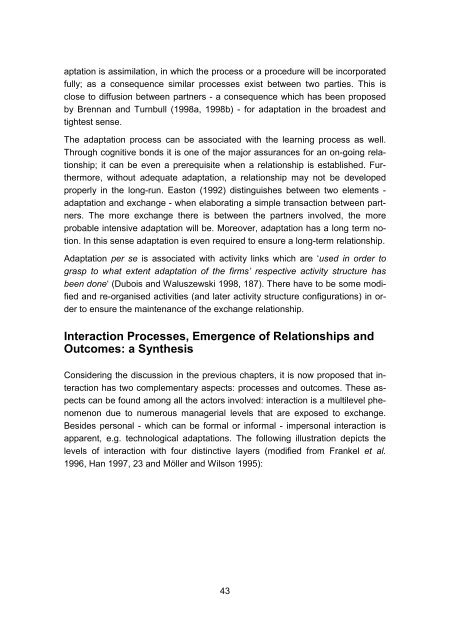849954 sisus
849954 sisus
849954 sisus
Create successful ePaper yourself
Turn your PDF publications into a flip-book with our unique Google optimized e-Paper software.
aptation is assimilation, in which the process or a procedure will be incorporated<br />
fully; as a consequence similar processes exist between two parties. This is<br />
close to diffusion between partners - a consequence which has been proposed<br />
by Brennan and Turnbull (1998a, 1998b) - for adaptation in the broadest and<br />
tightest sense.<br />
The adaptation process can be associated with the learning process as well.<br />
Through cognitive bonds it is one of the major assurances for an on-going relationship;<br />
it can be even a prerequisite when a relationship is established. Furthermore,<br />
without adequate adaptation, a relationship may not be developed<br />
properly in the long-run. Easton (1992) distinguishes between two elements -<br />
adaptation and exchange - when elaborating a simple transaction between partners.<br />
The more exchange there is between the partners involved, the more<br />
probable intensive adaptation will be. Moreover, adaptation has a long term notion.<br />
In this sense adaptation is even required to ensure a long-term relationship.<br />
Adaptation per se is associated with activity links which are ‘used in order to<br />
grasp to what extent adaptation of the firms’ respective activity structure has<br />
been done‘ (Dubois and Waluszewski 1998, 187). There have to be some modified<br />
and re-organised activities (and later activity structure configurations) in order<br />
to ensure the maintenance of the exchange relationship.<br />
Interaction Processes, Emergence of Relationships and<br />
Outcomes: a Synthesis<br />
Considering the discussion in the previous chapters, it is now proposed that interaction<br />
has two complementary aspects: processes and outcomes. These aspects<br />
can be found among all the actors involved: interaction is a multilevel phenomenon<br />
due to numerous managerial levels that are exposed to exchange.<br />
Besides personal - which can be formal or informal - impersonal interaction is<br />
apparent, e.g. technological adaptations. The following illustration depicts the<br />
levels of interaction with four distinctive layers (modified from Frankel et al.<br />
1996, Han 1997, 23 and Möller and Wilson 1995):<br />
43








